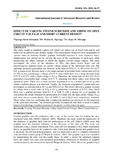| dc.contributor.author | Kimemia, David N. | |
| dc.contributor.author | Njoroge, W. K. | |
| dc.contributor.author | Mwangi, I. W. | |
| dc.date.accessioned | 2021-05-10T12:59:37Z | |
| dc.date.available | 2021-05-10T12:59:37Z | |
| dc.date.issued | 2018 | |
| dc.identifier.citation | IJARR, 3(9), 2018; 46-57 | en_US |
| dc.identifier.uri | http://erepo.usiu.ac.ke/handle/11732/4325;jsessionid=DE481C6794D5E5CF247ABD57E25D753A | |
| dc.identifier.uri | http://hdl.handle.net/123456789/4639 | |
| dc.description.abstract | The study sought to establish a photo cell which can reduce use of fossil fuels and in turn reduce on air pollution and climate change. The experimental design involved preparation of various ratios of titanium dioxide: graphite /iodine/KI mixtures in each respective layer. Optimization was carried out by varying the mass of the constituents of each layer while maintaining the others constant to obtain the highest current-voltage outputs. The study investigated the effect of the thickness of TiO2 (the photo active layer) and the electronegative material layers on current-voltage output of the fabricated solar cell. The optimum electricity generation was observed at the ratio of TiO2/ Cx: I2: KI as 0.4: 0.3: 0.17: 0.01 g respectively. Results show a very sharp increase in potential from a molar ratio of 0.1g of TiO2 to 0.4 g producing a voltage of 0.73 V after which there was a steep decrease from 0.73 V to 0.22 V with a short change of 0.1 g. Therefore, the molar ratio of (0.4: 0.2: 0.12) generated a reasonably high voltage of 0.73 V indicating that these values were almost the optimized ratios. There was a linear increase in potential up to a molar ratio of 0.5 g after which a uniform plateau was observed. Finally, the Variation of graphite-CX molar ratio was investigated at constant iodine (0.1 g) and TiO2 (0.5 g). The results showed a gradual increase in voltage from a molar ratio of 0.1g to 0.2 g generating a potential of 0.2 V, after which there was a gradual decrease from 0.2 V to 0.09 V with a change 0.2 g of graphite. In conclusion, the results obtained on optimization of a blank cell, the open circuit voltage (VOC) and short circuit current density (JSC) of 0.083 V and 0.33μA were respectively obtained. These values were low confirming that a conducting medium was necessary for the migration of the generated electrons. The research generally recommends that there is need to employ improved technology to reduce presence of air packets which creates air gaps. | en_US |
| dc.language.iso | en | en_US |
| dc.subject | Varying Titanium Dioxide, Iodine, Open Circuit Voltage, Short Current Density | en_US |
| dc.title | Effect of Varying Titanium Dioxide and Iodine on Open Circuit Voltage and Short Current Density | en_US |
| dc.type | Article | en_US |

